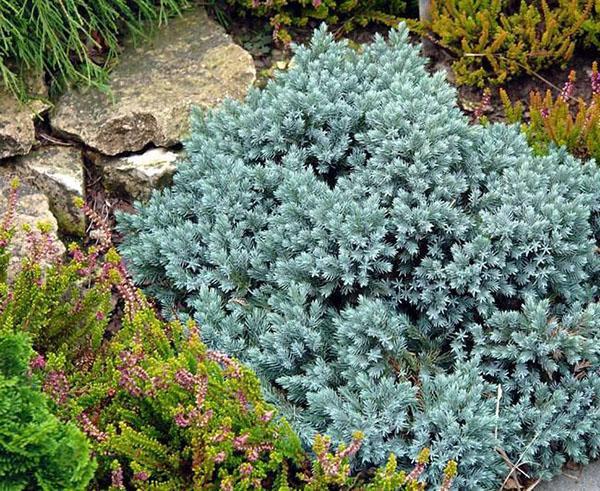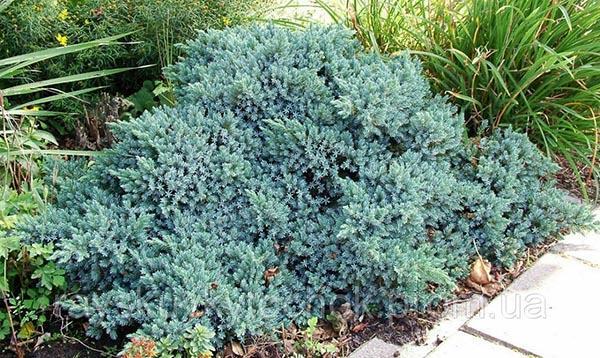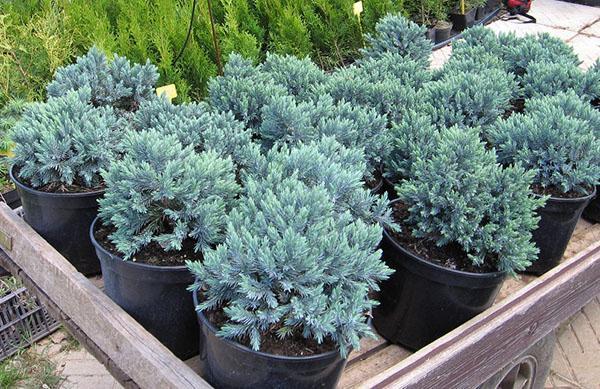Let's grow Blue Star scaly juniper on the site
 Compositions of coniferous plants look very beautiful and elegant, and they also purify the air and fill it with fragrance. Among these horticultural crops, Blue Star juniper stands out for its special appearance. This compact coniferous bush has a dense crown and spreading branches. It delights with its beauty, and its blue color can highlight the uniqueness of your garden landscape. Therefore, we need to get to know the beautiful plant in more detail.
Compositions of coniferous plants look very beautiful and elegant, and they also purify the air and fill it with fragrance. Among these horticultural crops, Blue Star juniper stands out for its special appearance. This compact coniferous bush has a dense crown and spreading branches. It delights with its beauty, and its blue color can highlight the uniqueness of your garden landscape. Therefore, we need to get to know the beautiful plant in more detail.
Description of Blue Star Juniper

The miniature size of the Blue Star juniper (as seen in the photo) allows you to plant the plant in containers and decorate loggias, balconies, and terraces. And also the shrub will be irresistible in compositions when landscaping the local area.
Coniferous garden culture is unpretentious to soil. The plant is capable of developing both on dense soils, and on loose ones, consisting of sand. The bush prefers sunny areas, but light partial shade will not interfere with it.
Juniper scaly Blue Star is considered a poisonous plant, its branches and fruits on them should be protected from children. Adults should also take precautions for handling ephedra.
Planting and caring for Blue Star junipers

The presented shrub is planted in holes that are 2-3 times larger in volume than the root system of the plant along with an earthen lump. For adult horticultural crops, the planting pit should reach a depth of 70 cm.A drainage layer must be placed on the bottom, it can be gravel or broken brick, its thickness is about 20 cm.
For planting Blue Star juniper, a soil mixture is prepared, consisting of:
- peat;
- land where turf grew;
- sand.
 Do it in a 2: 1: 1 ratio. It must have either a slightly acidic or neutral reaction.
Do it in a 2: 1: 1 ratio. It must have either a slightly acidic or neutral reaction.
During the planting process, make sure that the root collar of the plant is at the level of the soil, and in no case should it deepen.
A newly planted bush needs generous watering throughout the week. After landing, the Blue Star juniper is easy to care for. It consists:
- in soil moisture;
- in plant feeding;
- in shallow loosening and mulching;
- in the fight against pests and diseases;
- in the removal of dry branches.
When dry weather sets in, the ephedra needs watering. The bush does not tolerate dry air, so it will be very grateful to you for sprinkling.
 The first time the plant is fed in the spring. The end of April - the beginning of May is the most suitable period for fertilizing. To do this, give a nitroammofosk or a complete mineral dressing. In October, the plant is nourished potash-phosphorus fertilizer.
The first time the plant is fed in the spring. The end of April - the beginning of May is the most suitable period for fertilizing. To do this, give a nitroammofosk or a complete mineral dressing. In October, the plant is nourished potash-phosphorus fertilizer.
It is advisable to periodically loosen to make the topsoil breathable and permeable. Also, this action destroys weeds.
The development of the shrub will be more intensive if the soil is mulched in the spring. This procedure will also help to improve moisture and air penetration. The area prepared near the plant is sprinkled with complex dressing, sand and sawdust. Then mulch is put, which consists of decorative stones. A layer of 8 cm will be enough for this.
 If the Blue Star juniper is affected by fungal diseases, then it must be treated with fungicides. For the prevention of these diseases, 1% Bordeaux liquid is used. Insects such as caterpillars and aphids can be eliminated by using insecticides. It is necessary to process this garden culture with a solution 2 times a week.
If the Blue Star juniper is affected by fungal diseases, then it must be treated with fungicides. For the prevention of these diseases, 1% Bordeaux liquid is used. Insects such as caterpillars and aphids can be eliminated by using insecticides. It is necessary to process this garden culture with a solution 2 times a week.
The wintering of the ephedra is carried out without shelter, but if the plants are still young, then they can be covered with spruce branches. Particular attention is paid to the spring sun, as the shrub can get burned. To prevent this from happening, it is also covered with spruce branches or sandbod.
 The plant does not need special pruning, but if you see damaged branches during inspection, then they must be removed.
The plant does not need special pruning, but if you see damaged branches during inspection, then they must be removed.
If you regularly take proper care of the Blue Star scaly juniper, it will grow lush, with beautiful blue needles.
Photo of Blue Star juniper in landscape design
This plant creates a contrast in landscape design with most coniferous and deciduous ornamental crops. Gardeners are happy to include it in compositions with other plants because of its compact dense needles and blue color with a silvery sheen. The shrub will look spectacular in rocky gardens, rock gardens, low hedges. Juniper Blue Star in landscape design (pictured) creates a unique beauty and is favorably combined with various decorative cultures.





The use of Blue Star juniper in the arrangement of your garden plot is worthy of your attention. Buy a few more varieties of plants with different colors of needles, which will make the compositions even more interesting.